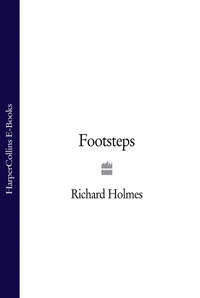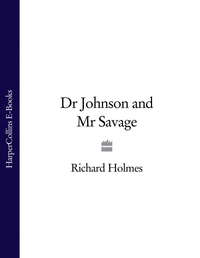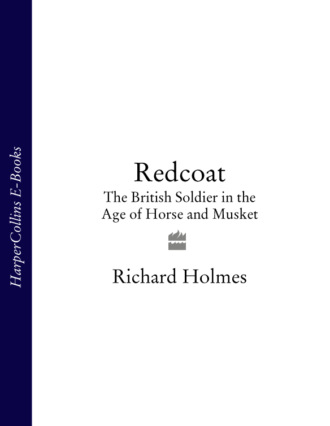
Полная версия
Redcoat: The British Soldier in the Age of Horse and Musket

Redcoat
The British Soldier in the Age of Horse and Musket
Richard Holmes
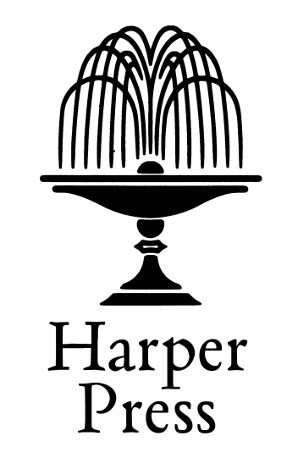
Copyright
HarperCollinsPublishers 1 London Bridge Street London SE1 9GF
www.harpercollins.co.uk
First published in Great Britain by HarperCollinsPublishers2001
Copyright © Richard Holmes 2001
Richard Holmes asserts the moral right to be identified as the author of this work
Maps by John Gilkes
All rights reserved under International and Pan-American Copyright Conventions. By payment of the required fees, you have been granted the non-exclusive, non-transferable right to access and read the text of this e-book on screen. No part of this text may be reproduced, transmitted, downloaded, decompiled, reverse engineered, or stored in or introduced into any information storage and retrieval system, in any form or by any means, whether electronic or mechanical, now known or hereinafter invented, without the express written permission of HarperCollins e-books.
HarperCollinsPublishers has made every reasonable effort to ensure that any picture content and written content in this ebook has been included or removed in accordance with the contractual and technological constraints in operation at the time of publication.
Source ISBN: 9780006531524
Ebook Edition © 2011 ISBN: 9780007374052
Version 2016-08-11
‘Until yesterday I had not seen any British infantry under arms since the troops from America arrived, and, in the meantime, have constantly seen corps of foreign infantry. These are all uncommonly well dressed in new clothes, smartly made, setting the men off to great advantage – add to which the coiffure of high broad-topped shakos, or enormous caps of bearskin. Our infantry – indeed, our whole army – appeared at the review in the same clothes in which they had marched, slept and fought for months. The colour had faded to a dusky brick-red hue; their coats, originally not very smartly made, had acquired by constant wearing that loose easy set so characteristic of old clothes, comfortable to the wearer, but not calculated to add grace to his appearance. Pour surcroit de laideur, their cap is perhaps the meanest, ugliest thing invented. From all these causes it arose that our infantry appeared to the utmost disadvantage – dirty, shabby, mean, and very small. Some such impression was, I fear, made on the Sovereigns, for…they remarked to the Duke what very small men the English were. “Ay,” replied our noble chief “they are small; but your Majesties will find none who fight so well”.’
Captain Cavalié Mercer, Royal Horse Artillery, describing a review of the British army by the Allied sovereigns.
Paris 1815
Table of Contents
Cover Page
Title Page
Copyright
Epigragh
INTRODUCTION
MAPS
I THE AGE OF BROWN BESS
THAT ARTICLE THERE
SCARLET AND BLUE
TO FLANDERS, PORTUGAL AND SPAIN
RED COAT AND BROWN BESS
ENGLAND, HOME AND BEAUTY?
II ALL THE KING’S HORSES AND ALL THE KING’S MEN
SWORD AND STATE
LINE OF BATTLE
III BROTHERS OF THE BLADE
SCUM OF THE EARTH
EPAULETTE GENTRY
IV HORSE, FOOT, GUNS – AND WOUNDS
MARCHING REGIMENTS
GALLOPING AT EVERYTHING
THE NIMBLE GUNNER
CURRENCY OF WAR
V HOME FIRES
MORE LIKE PRISONS
DAUGHTERS OF THE REGIMENT
CARROT AND STICK
VI FOREIGN FIELDS
CHAIN OF COMMAND
THE TROOPER’S ON THE TIDE
THE PAINFUL FIELD
THE IMMINENT DEADLY BREACH
CAPTAINS IN OPEN FIELD
EPILOGUE
WORTHY OF REMEMBRANCE
References
Bibliography
Index
Acknowledgements
About the Author
Praise
Also By Richard Holmes
About the Publisher
INTRODUCTION
I HAVE NEVER really got on with Bertolt Brecht, but cannot deny that he had a point in asking, however rhetorically, whether Caesar crossed the Rubicon all by himself. Of course he did not, any more than Cornwall is surrendered at Yorktown on his own, Wellington won Waterloo single-handed, or Cardigan hacked down the Valley of Death at Balaclava with only his bright bay charger Ronald for company. This is not a book about great, or even not-so-great, generals, though both feature in it from time to time. And it is not about battles either, even if we are rarely very far away from them. Instead, its concern is for the raw material of generalship and the pawns of battle, the regimental officers and soldiers (and their wives, sweethearts and followers of a less defined and sometimes rather temporary status) that served in the British army in a century when it painted the world red.
Hollywood is entertainment rather than history, though its tendency to use the past as a vehicle for story telling blurs fact and fiction so that the latter assumes, however unintentionally, the authority of the former. The redcoat has recently featured on the screen in a role depressingly reminiscent of that assigned to the German army after the Second World War. Brutal or lumpish soldiers are led by nincompoops or sadists with the occasional decent fellow who eventually allows a mistaken sense of duty to win the battle with his conscience. Watch Rob Roy, Last of the Mohicans or, most recently, The Patriot, and you will wonder how this army of thugs and incompetents managed to fight its way across four continents and secure the greatest empire the world has ever seen.
That it was an army born of paradox, forged in adversity, often betrayed by the government it obeyed and usually poorly understood by the nation it served, is beyond question. It drank far too much and looted a little too often, and its disciplinary code threw a long and ugly shadow onto the early twentieth century. It sometimes lost battles: we shall see it ground arms in surrender at Saratoga in 1777 and Yorktown in 1781, wilt under Afghan knives on the rocky road from Kabul in 1842, and quail under Russian fire before Sevastopol’s Great Redan in 1855. Yet it very rarely lost a war. In victory or defeat it had a certain something that flickers out across two centuries like an electric current. Little of that was generated by a military organisation which was a characteristically British mixture of tradition wrapped in compromise, and fuelled by the quest for place, perquisites or status. And, important though high command was, this was an army that fought as hard when mishandled by Beresford at Albuera in 1811 as it did when commanded with genius by Wellington at Salamanca the following year. It drew its enormous tensile strength not simply from the fear of punishment and the lure of reward, though both were important, but from that elusive chemistry that binds men together in the claustrophobic world of barrack-room and half-company, officers’ and sergeants’ messes, smoke-wreathed battle line and darkling campsite. If I deplore its many faults, I love it for its sheer, dogged, awkward, bloody-minded endurance, the quality that inspired its exasperated adversary Marshal Soult to complain after Albuera: ‘There is no beating these British soldiers. They were completely beaten and the day was mine, but they did not know it and would not run.’
A word about methodology. The architecture of this book is my own, though there is no doubting the fact that I learnt how to ply my ruler and dividers a quarter of a century ago in the Sandhurst drawing office of Messrs Duffy and Keegan. Sir John Fortescue’s venerable multi-volume History of the British Army (superseded in many areas but still surprisingly useful in others) helped form a solid foundation. For the book’s framework I am fortunate in being able to rely on scholars who have provided me with the academic equivalent of RSJs, those broad, load-bearing studies, which no professional historian can do much work without. These are works by authors like Alan Guy and John Houlding for the army of the eighteenth century, Michael Glover, Ian Fletcher and Philip Haythornthwaite for Wellington’s army, and Hew Strachan, Edward Spiers and Donald Huffer for the army of the early nineteenth century.
Individual studies provide the equivalent of ducting and plumbing. Brian Robson has made the swords of the period his own, and Howard Blackmore and Christopher Roads have its small arms at their disposal. The Marquess of Anglesey has charted the fortunes of the British cavalry in his multi-volume history. Elizabeth Longford’s biography of Wellington remains unsurpassed, though Christopher Hibbert’s more recent personal history is an easier read. I cannot speak too highly of Mark Adkin’s study of the Charge of the Light Brigade, and I am grateful that need to amass suitable building materials drew me to Frank McLynn’s work on crime and punishment in Georgian England, for it was in a part of the yard not often visited by military historians.
Onto this robust structure I have bolted dozens of personal accounts, letting the men who wore the red coat speak for themselves whenever I can. I had encountered some, like John Kincaid and William Grattan, when an undergraduate, and rediscovering them many years on was like meeting a well-preserved old flame in a King’s Parade coffee-shop, and discovering that age has not wearied nor the years condemned. Others were unfamiliar. It is thanks to the Army Records Society that Thomas Browne and John Peebles feature so prominently in these pages, and to Spellmount Publishers that William Tomkinson’s Peninsula journal, to name but one of their invaluable books, has escaped from the antiquarian booksellers to which rarity had previously confined it. I have had some pieces of unaccountable good luck: discovering the manuscript Order Book of General Sir William Howe, commander in chief in North America, in the library at the Joint Services Command and Staff College at Watchfield was perhaps the most striking.
So many of the memoirs of the period were written by non-commissioned personnel that I am confident in my denial of the charge that this sort of book is simply epaulette history, giving the officer’s view. Robert Waterfield, Thomas Morris and John Cooper of the line infantry, Benjamin Harris and Edward Costello of the Rifles, and John Pearman of the light dragoons are amongst those who remind us what it was like to be ‘an atom of an army’, as one of their most articulate comrades, Thomas Pococke, actor turned reluctant private soldier of the 71st Regiment, was to put it. And of course there is the incredible John Shipp, twice commissioned from the ranks – once for spectacular bravery in the field. I have tried to provide references for all substantive quotations, and list memoirs and collected letters by the name of their writer rather than their editor: the bibliography, really a working list of books actually used, makes this clear.
My approach is thematic rather than chronological. By and large I start with big issues and move on to smaller ones, first examining the army’s size and composition, the character of the society that produced it, and the part it played in the nation’s defence policy. Thereafter I review the army’s administration and overall structure, its officers and men, and tactics of the combat arms and the effects produced by their weapons. The last two chapters consider the soldier’s daily life in peace and war respectively. Such an approach shuns easy categorisation. It is impossible, for example, to separate pay in peacetime from prize money in wartime. Any attempt to place the contribution made by women in a separate chapter might have the benefit of political correctness but would miss the point that they formed an inseparable part of the army, whether getting the Duke of York into trouble with Parliament, consoling the amorous Ensign Lord Alvanley, rising to become inspector general of the medical department while disguised as a man, or simply supporting their own men in rain and shine, and under shot and shell, from Aldershot to Amballa and the Curragh to the Crimea. So you will find them, the Colonel’s Lady and Judy O’Grady alike, where you least expect them.
I have not written for what are unkindly termed ‘military buffs’: indeed, those who go in for the martial equivalent of train spotting will complain that I have paid scandalously little attention to the raising, disbandment, re-raising and renumbering of infantry regiments in the eighteenth century, and so I have. My comments on uniform are very broad: this is not the place to discover which regiments were fortunate enough to wear bastion-ended lace on their tunics. And as to the minutiae of ‘off-reckonings’ and ‘net-reckonings’ in regimental accounting, well, if they perplexed the great Sir John Fortescue, they can scarcely do less for me.
The general reader might appreciate some simple definitions, although the British army is not a creature that thrives on simplicity. Officers, ‘commission-officers’ to the seventeenth century and commissioned officers to later generations, held rank and authority from a commission signed by the monarch. The field marshal, a comparatively rare bird, was their most senior. There were three grades of general officers, general, lieutenant general and major general. Major generals are, confusingly, junior to lieutenant generals, partly because their rank was once ‘sergeant major general’ and partly because the lieutenant general (as implied by the word lieutenant wherever it appears) stood in for his master when required. Brigadier generals and brigadiers – terminology changed over the period – held a temporary rank from which they might be advanced or not, as the case might be, and were analogous to commodores in the Royal Navy, who were captains temporarily holding a senior appointment.
There were two sorts of colonels. What we may call colonels proper held a substantive rank from which seniority would eventually, provided they lived long enough, elevate them to join the generals. Colonels of regiments, in contrast, were usually not colonels at all but general officers acting as regimental proprietors, dispensing patronage, making a profit, and warning the young, over a glass of port, that standards were slipping. Field officers comprised lieutenant colonels and majors, while company officers were captains, lieutenants and cornets (for the cavalry), ensigns (for most of the infantry), and second lieutenants (for the artillery, engineers and a few infantry regiments). Quartermasters were regimental officers responsible for supplies and quartering, and adjutants (the term was an appointment, not a rank, and its holder would be termed correctly, ‘lieutenant and adjutant’ or ‘captain and adjutant’) assisted the regiment’s commanding officer in drill, administration – and in the case of Colonel John Wilkes MP of the Middlesex Militia, duelling.
Non-commissioned officers began with sergeant majors, grave and reverend gentlemen of whom there was one per infantry battalion, although the cavalry had one regimental sergeant major and a troop sergeant major for each of its troops. Staff sergeants were senior sergeants on the staff of regimental headquarters rather than one of its subordinate companies, and colour sergeants, a rank introduced into the infantry in 1813, ranked senior to other sergeants and had a very imposing arm badge to prove it. Sergeants were a cut above junior non-commissioned officers, corporals in most arms and bombardiers in the Royal Artillery. The appointment of a chosen man, a private soldier selected by his commanding officer to deputise for a corporal, eventually became that of lance corporal. And as to captain-lieutenants, sub-brigadiers and file-majors: well, I will explain about these worthies when they feature in my story.
The regiment, usually commanded in the field by a lieutenant colonel, was the basic building block in the infantry and the cavalry. As time went on infantry regiments tended to have more than one battalion, and in the British army these battalions, lieutenant colonels’ commands, usually fought independently from the other battalions of their regiment. In these pages I follow the convention of showing 1st Battalion 33rd Regiment as 1/33rd, while 1st Battalion 1st Foot Guards is 1/1st Foot Guards. I use 33rd Foot and 33rd Regiment, as contemporaries did, almost interchangeably: do not be concerned, for they are the same creature. The company, a captain’s command, was the main sub-unit of the infantry, and the troop was its cavalry equivalent. Cavalry troops were often paired to make squadrons. Infantry battalions and cavalry regiments were formed into brigades, and brigades into divisions, though the precise nature of this combination varied from time to time.
Pay, bounties, prize money and loot played an important part in the motivation of officers and men alike. I am constantly exasperated by authors who give no idea what money was worth in practical and comparative terms. To be told that if an item cost 100 units in 1680 then it cost 123 units in 1750 is unhelpful, and to suggest that a pound then was worth x times more than now is rarely a safe comparator across a broad range of income and expenditure. I far prefer what some have termed the ‘Mars Bar Comparator,’ which looks at the prices of staple items over the period to provide a practical idea of what money was really worth. There were twelve pence (d) to a shilling (s) and twenty shillings to a pound. A guinea was worth one pound and one shilling. And an Irish shilling, exasperating to those paid in it, was worth a penny less than an English one.
But before we consider what Ensign Alvanley paid for his claret and Rifleman Harris for his bread and cheese, there are a number of important caveats. First, the idea of subsistence wages for agricultural workers may be a misjudgement, as such folk often raised their own pigs and chickens, cultivated cottage gardens, and benefited from a trickle-down income in kind as master’s old coat became ploughman Jethro’s best, and mistress’s worn-out petticoat found a new (and possibly more exciting) incarnation as chambermaid Eliza’s drawers. Second, modern ideas of inflation have little relevance to the period in question, where inflation did not rise steadily, but went up and down, sometimes quite sharply: it rose by 36 per cent in 1800 and fell back by 22 per cent in 1802. Prices were generally quite stable except at times of particular hardship, and a pint of decent porter (a more sustaining brew than watery small beer) cost around 2d for most of the period. Finally, there were wide regional variations in pay, and in the prices of goods not easily available locally. The Midlands and the North were the ‘Silicon Valley’ of the age, where there was good money to be made always provided one was not, like the handloom weavers who formed such an important element of the Wellingtonian army, sidelined by new technology.1
For most of our period an infantry soldier was paid a shilling a day, out of which an assortment of stoppages were deducted which might leave him with very much less. He would receive two (later three) meals a day, one of them usually including plenty of beef, bread and small beer. In 1750 a London labourer received 2s a day and a craftsman 3s. A day labourer in Gloucestershire drew is 4d but the same man picked up only 9d a day in the North Riding of Yorkshire. A mason or joiner earned 2s a day. In 1760 the weekly poor relief paid to a pauper by the parish was just is 6d. In contrast, the aristocrats of labour were respectably paid in 1790, with a chair-carver receiving £4 a week, a London compositor 24s, a London saddler 15s, a Newcastle Collier 13s 6d, a worker in the Worcester potteries 8s 7d, a Lancashire weaver 8s 7d and a woman textile worker 4s 3d.
By 1800 an agricultural worker received 10s a week, rising to 12s in 1812: in 1815 a skilled Lancashire weaver collected £2 4s 6d. In 1817 our farm labourer was receiving only 7s 6d a week, though by 1850 this had risen to 11s. A man robust enough to take work as a heavy clay digger at this time, however, brought home 2s 6d a day, which, at 15s for a six-day week, was good money for a labouring man. In 1820 a village schoolmistress earned £20 a year.
In 1760 a large tot (probably a quarter pint) of cheap gin cost 1d and beer was 2d a pint: if one was drinking simply for effect, as so many were, then liquor was not simply quicker but cheaper. A dozen bottles of claret cost £1. A bread and cheese supper cost 3d, a dinner of cold meat, bread, cheese and beer 7d, and a slap-up meal in a chophouse, with a steak smoking enticingly at its centrepiece was 1s. A cheap room cost 2s a week to rent, a smart town house on Grosvenor Square was £300 a year, and a prosperous merchant in Colchester might house and feed his wife, four children and servants for £350 a year. 6s 6d bought a sturdy gown for a servant girl, and £8 a year, all found, hired her for a year. A clerk’s suit cost £4 10s and a gentleman’s £8 8s.
In 1762 James Boswell, whose father gave him an allowance of £25 every six weeks, stayed in Queen Street, Westminster – ‘an obscure street but pretty lodgings’ – for £22 a year. He paid the Jermyn Street sword-cutler Mr Jeffreys five guineas for a handsome silver-hilted small-sword; a ‘low brimstone’ girl demanded 6d to permit him to ‘dip my machine in the Canal’, and his surgeon charged him five guineas to cure the resultant gonorrhoea. Lord Alvanley, who had similar weaknesses but more money with which to indulge them, gave five guineas for one night with the blonde and well-upholstered Mrs Dubois in 1808. I hope that she was worth what a working man could only have regarded as absurdly conspicuous expenditure.
A quartern loaf (weighing 41b 50z) cost 6d or 8d in 1790 but 15d or 16d in 1801, though it had dropped to 9d in 1830 and was 1s in 1850. In 1796 model cottages cost £58 in wood or £66 in brick. It cost about 30s to £2 a year to rent a cottage in 1790 and £5 to £10 a year in 1824. In 1815 a coat cost £1 7s 1d in Chelsea and shoes were 7s a pair. A lady’s good serge suit was £1 in 1850. In 1859, a clean unskilled labourer in London, taking home 18s a week, would spend 4s of it on bread, 1s 2d on beer, 3s 6d on meat and potatoes, 1s 6d on butter and cheese, 6d on wood and candles, 1s on coal, 2s 6d on clothes and shoes, 2s on rent and 10d on soap and sundries. In 1813 the standard infantry musket cost around £2, and it is high time that we turned our attention to these artefacts of walnut, brass and steel and to the men who used them.
MAPS
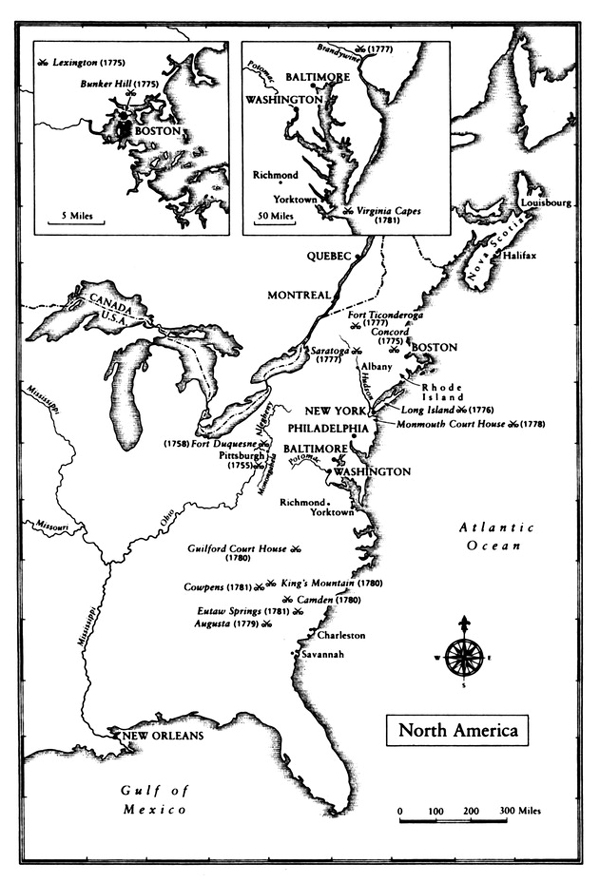
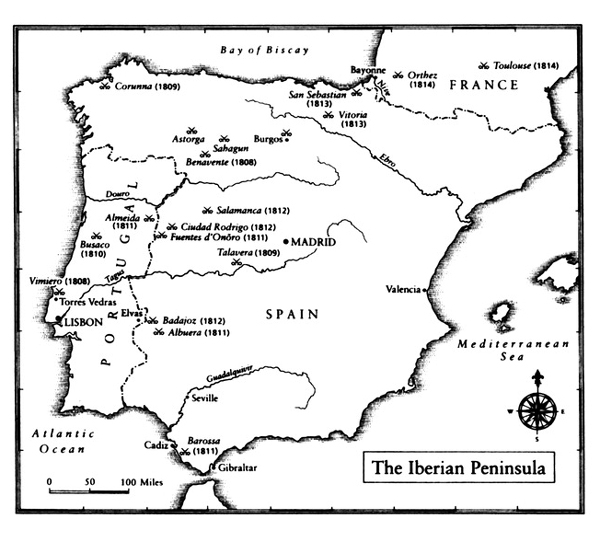
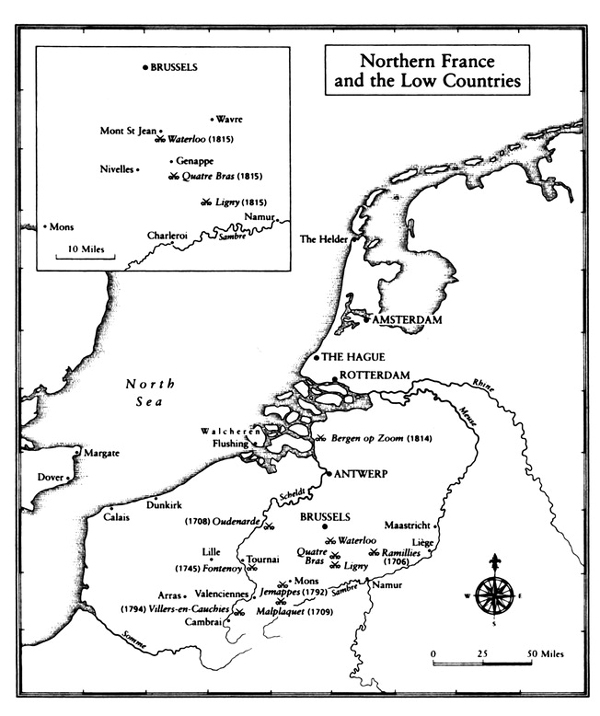
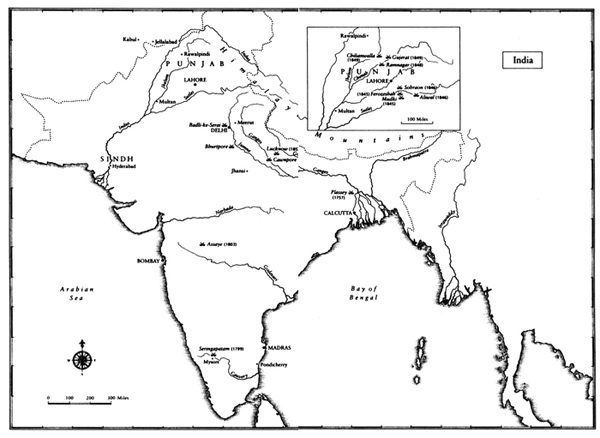
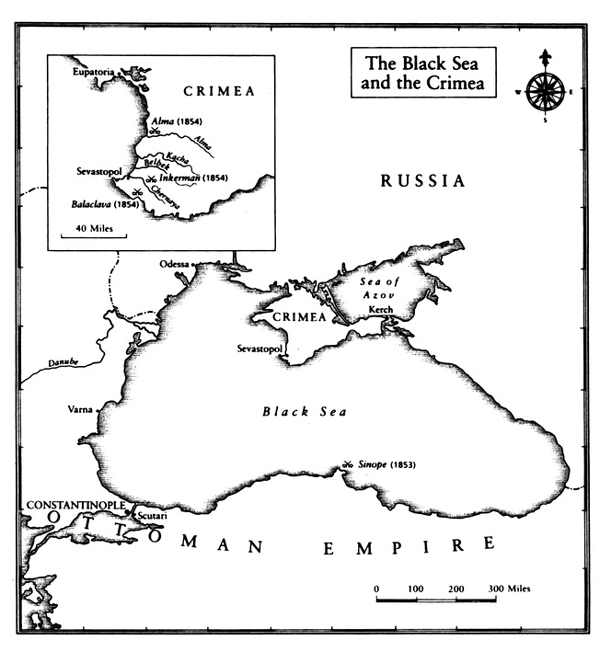
THAT ARTICLE THERE
HE HAS NOT SHAVED this morning. And from the look of things he shaved neither yesterday nor the day before. Ginger stubble sprouts from a sun-tanned face, with red-rimmed blue eyes and a mouth whose teeth stand anyhow, like a line of newly raised militia. Bushy sideburns, ending in a forward sweep just below the ear, emerge from a battered black shako fronted with an oval brass plate and topped with a white over red pom-pom which has seen better days, and many of them. His red coat, waist-length in front, with short skirts at the back, is closed by ten pewter buttons, grouped in twos, with a broad oblong of white worsted lace framing the button holes. Its high collar and deep cuffs are yellow, and trimmed with more white lace. The effect is not improved by the fact that collar and coat-front alike are flecked with small burns made by gunpowder. Around his neck is knotted a piece of material which is now unquestionably black, though it might be that it started out much lighter. Grey trousers, knees and seat patched with cloth which has an uncanny resemblance to that worn by Franciscan friars, hang loose, without benefit of gaiter, over square-toed black boots.






